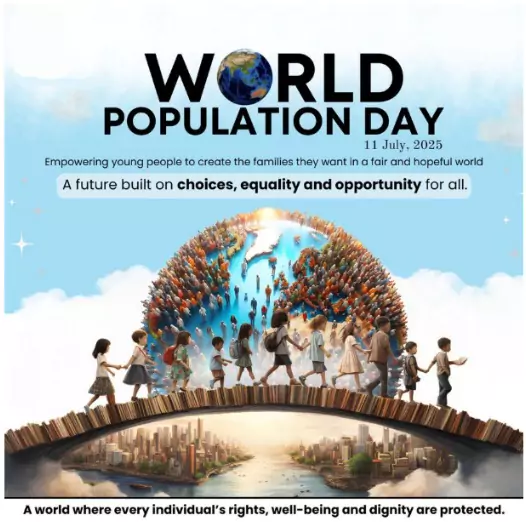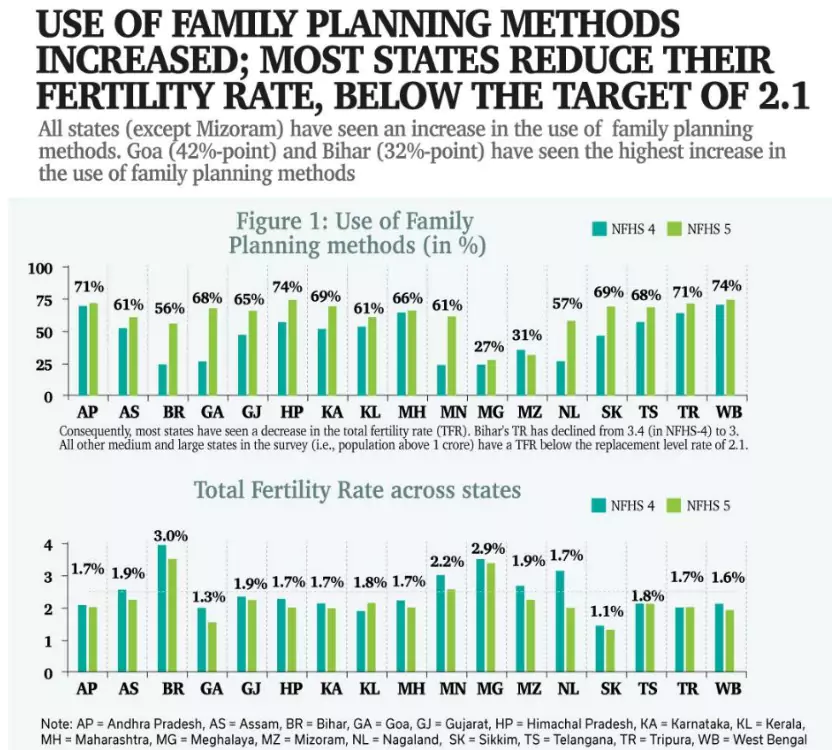World Population Day 2025, observed on July 11, highlights rising concerns over declining fertility rates and emphasizes youth empowerment and rights-based policies to ensure equitable population growth and sustainable development.
About World Population Day

- Establishment: The United Nations Development Programme (UNDP) was established in 1989, the day after Dr. K.C. Zachariah, a renowned demographer, proposed the concept of a ‘World Population Day’.
- Origin: To the “Day of Five Billion” (July 11th, 1987), when the world population had touched five billion (in 1987) and challenges such as poverty, health and gender inequality were plaguing the world, developing countries in particular.
- Theme for 2025: “Empowering young people to create the families they want in a fair and hopeful world.”
- Focus: Youth-centered policies, reproductive rights, and informed decision-making in shaping family, career, and life choices.
- Objectives of World Population Day
- Raise Awareness of population dynamics, family planning, and demographic challenges.
- Promote Sexual and Reproductive Health and Rights (SRHR): Encourage access to contraception, maternal care, and reproductive education
- Support Youth Aspirations through skilling, healthcare, and economic opportunities
- Advocate for Gender Equality: Focus on girls’ education, economic inclusion, and bodily autonomy.
- Highlight Environmental Concerns: Link population management with resource sustainability and climate change.
- Foster Global Cooperation in addressing shared population issues.
- Encourage Data-Driven Planning for population and development strategies.
- Align with SDGs: Especially with Goals 3 (Good Health and Well-being), 5 (Gender Equality), 10 (Reduced Inequalities), and 12 (Responsible Consumption and Production)
Global Demographic Trends
- World Population Prospects Report: The global population is projected to grow from 8.2 billion in 2024 before peaking at around 10.3 billion in the mid-2080s.
- The world’s population is expected to reach 2 billion in the next 30 years and 9.7 billion in 2050.
- Most Populous Countries: The two most populous countries are India and China; both have over 1 billion people, representing nearly 18% of the world’s population.
- United Nations Fund for Population Activities (UNFPA) 2025 Report: “The Real Fertility Crisis”:
-
- 20% globally unable to realise desired family size.
- Barriers include infertility (13%), financial constraints (38%), housing and childcare gaps, and unemployment.
- Case Example: South Korea’s $200 billion investment to reverse fertility decline saw 7.3% rise in births (Quarter 1 2025), showing policy responsiveness can yield measurable demographic outcomes.
India’s Demographic Potential
- Largest Youth Cohort Globally: 371 million youth (15–29) — the largest in the world (UNICEF).
- India is at the heart of a demographic dividend window (2005–2055).
- Strategic investments can boost GDP by $1 trillion by 2030 (World Bank, NITI Aayog).
- Economic & Strategic Leverage: Labour market edge over ageing societies (e.g., Japan, EU).
- Catalyst for urban innovation, digital economy, and entrepreneurship.
- Youth-led development can transform India into a global talent and manufacturing hub.
- United Nations Population Fund (UNFPA) Report: In April 2023, India overtook China to become the world’s most populous country, with more than 1.4 billion citizens.
 As much as 68% of India’s population belongs to the 15-64 years category, and 26% in the 10-24 years group, making India one of the youngest countries in the world.
As much as 68% of India’s population belongs to the 15-64 years category, and 26% in the 10-24 years group, making India one of the youngest countries in the world.- The percentage of the elderly population has been increasing from 6.8% in 1991 to 9.2% in 2016.
- Factors for Slow Rate of Population Growth: Increased use of contraceptive methods, spacing of pregnancies, access to health care and the impetus to family planning, besides increasing wealth and education.
- Decline in Fertility Rate: According to the Sample Registration System survey conducted yearly by the Indian government, the birth rate declined steadily from 2011 to 2020.
- According to the National Family Health Survey (NFHS)-5, India’s total fertility rate (TFR) decreased from 3.4 to 2 between 1992 and 2021, dropping below the replacement level of 2.1.
- It means below the replacement level of fertility, or the rate at which a generation replaces itself.
- However, the number of people in the country is still expected to continue to rise for the next few decades, hitting its peak of 1.7 billion by 2064.
- Decline in Mortality Rates: There has been a significant drop in the mortality rate as well.
- The average life expectancy of Indians has also increased over time. With this, India is experiencing a demographic shift, towards an ageing population.
- Maternal Mortality Rate (MMR): India has made remarkable progress in reducing its MMR. It significantly decreased from around 384 (or 362 by some estimates) in 2000 to 80 in 2023.
- This progress puts India on track to meet or surpass its national target of 100 or less by 2025 and move closer to the Sustainable Development Goal (SDG) target of less than 70 by 2030.
- Mortality Rate for Children under Five: It reduced significantly post 2000s.
- UNICEF highlighted that India achieved a 70% reduction in under-five mortality since 2000 and a 78% reduction from 1990 to 2023.
- Infant Mortality Rate (IMR): The recent data from the Sample Registration System (SRS) shows a significant decline in India’s IMR.
- In 2021, the IMR dropped to 27 per 1,000 live births, compared to 39 per 1,000 live births in 2014.
- According to the 2011 Census, individuals aged 60 years and above constituted 8.6% of the total population. The figure is projected to rise to 19.5% by 2050.
- Migration and Urbanisation: India’s significant rural-to-urban migration, primarily of the working-age population, continues to fuel the urban labor force.
- This demographic shift drives urban growth but necessitates robust planning for infrastructure, housing, and sustainable urban development.
- By 2030, over 40% of India’s population is expected to reside in urban areas (Economic Survey 2023-24 projection).
- A report from the Economic Advisory Council to the Prime Minister (EAC-PM) highlights a sharp drop in rural-to-urban migration in India. The migration rate fell from 37.6% in 2011 to 28.9% in 2023.
- However, despite this decline in overall rural-to-urban migration, cities continue to absorb a significant number of migrants. For instance, 58% of the urban migrant population in 2020-21 had moved from rural areas.
- Other Components: In addition to fertility, mortality, and migration, the following factors also play a significant role:
- Public Policy: Such as Family policy, immigration policy, health policy, education policy, etc. have a significant impact on demography of India.
- Environmental Factors: Environmental factors and demography influence each other.
Barriers to Realizing Demographic Potential
- Unmet Reproductive Needs: According to NFHS-5, 36% of women face unintended pregnancies, while 30% report unmet fertility goals, reflecting gaps in reproductive autonomy and service delivery.
- Child Marriage and Adolescent Pregnancy: Despite a decline since 2006, child marriage remains high at 23.3%, and 7% of adolescent girls experience early pregnancies, with pronounced regional and socio-economic disparities.
- Gender Inequality: Female labour force participation remains below 25%, constrained by entrenched patriarchal norms, limited access to education, and poor employment opportunities.
- Inadequate Sexual and Reproductive Health and Rights (SRHR) Services: SRHR services, including access to contraception, safe abortion, fertility care, and maternal health, are inconsistent and under-resourced, particularly in rural and underserved areas.
- Socio-Cultural Barriers: Stigma, misinformation, and lack of youth-friendly, rights-based services continue to restrict informed reproductive choices and agency, especially among adolescents and marginalized communities.
India’s Policy Responses
- Flagship Schemes:
- National Population Policy (NPP) 2000 aimed to stabilize India’s population by 2045 through a multi-pronged strategy focused on:
- Achieving TFR of 2.1 (replacement level) by 2010
- Improving reproductive and child health
- Promoting voluntary family planning
- Empowering women through education, health, and decision-making rights
- Beti Bachao, Beti Padhao: Addresses child marriage, girl education, and empowerment.
- National Adolescent Health Programme: Enhances health literacy and reproductive rights.
- Skill India Mission – PMKVY 4.0 (2023–24): Targets industry-relevant skill training for youth, with focus on emerging sectors (AI, robotics, green jobs) and gender-inclusion in skilling.
- Anaemia Mukt Bharat & POSHAN 2.0: Focused on tackling malnutrition and anaemia in women and adolescents through community-based interventions and convergence of services.
- SAMARTH Campaign (MoWCD, 2023): A digital initiative to enhance awareness and mobilize community action for gender equality and women’s empowerment.
- Digital Health Mission (Ayushman Bharat Digital Mission – ABDM): Facilitates digital health records, expanding access to SRHR services, especially for youth and women.
- Tele-MANAS (2022): A mental health support initiative under NMHP offering free tele-counseling, essential for youth psychological well-being and productivity.
- PM POSHAN Scheme (revamped 2021): Former Mid-Day Meal scheme, now emphasizes nutritional support, health, and school attendance, especially critical for girls and adolescent development.
- Mission Vatsalya (2021): Focuses on child welfare and protection, ensuring safety, health, and development of vulnerable children through integrated child protection services.
- National Education Policy (NEP) 2020: A transformative framework promoting multidisciplinary learning, skill development, and early childhood education, aimed at preparing a future-ready youth workforce.
- Mission Shakti (2020): An umbrella scheme for women’s safety, empowerment, and support, merging key components like One Stop Centres, Women Helplines, Swadhar Greh, and Beti Bachao Beti Padhao under two sub-schemes—Sambal and Samarthya.
Best Practice Models: Following are various best practice models of Indian states:
- Project Udaan (Rajasthan, IPE Global):
- Prevented 30,000 child marriages, 15,000 teen pregnancies (2017–22).
- Enabled contraceptive access and incentivised schooling.
- Project Advika (Odisha, UNICEF-UNFPA):
- Created 11,000 child marriage-free villages.
- Stopped 950+ marriages in 2022 through awareness and skill-building.
- Project Manzil (Rajasthan):
- Trained 28,000+ young women (18–21 years); 16,000 employed.
- Increased financial independence, delayed early marriage, and promoted gender-friendly workplaces.
|
Way Forward
- Empower through Rights and Resources- Universal SRHR Access: Contraception, abortion, fertility treatment, mental health, and education must be universally available.
- Expand Girls’ Education: Each additional year of secondary education cuts child marriage risk by 6% (UNICEF).
- Structural & Behavioural Reforms- Youth-Centric Skilling: Align aspirations with market demand through human-centred design (e.g., Manzil model).
- Female Workforce Boost: Ensure job dignity, workplace safety, childcare, housing, and transport for working women.
- Normative Shifts: Counter stigma via life-skills education, community campaigns, and local youth champions.
- Decentralised Planning: Empower states/districts with data-driven, locally adapted strategies.
- Correcting Myths around Population Collapse- Malthusian Alarmism Is Outdated: Population momentum ensures growth despite fertility decline.
- Malthusian Alarmism: A theory by Thomas Malthus warning that unchecked population growth will outstrip resource (especially food) supply, leading to famine, poverty, and societal collapse.
- Projection is not Prediction: Demographic forecasting is uncertain and policy-contingent.
- Collapse Narratives Often Elitist: Tend to ignore deeper structural inequities, choice restrictions, and gender justice.
- Building Human Capital: There is a need to invest in healthcare, quality education, jobs and skills to build human capital, which can in turn support economic growth, end extreme poverty, and create a more inclusive society.
- Improvement of Health and Nutrition: Improvement in healthcare infrastructure would ensure a higher number of productive days for the young labour-force, which increases the productivity of the economy.
- Non-Communicable Diseases (NCDs), which incur high out-of-pocket expenditures, are catastrophic for some families. India needs a stronger safety net to save these families from slipping into utter poverty.
- The nutrition scenario should be set right by strengthening programmes. This will require an increase in budgetary allocation for the health and nutrition sectors.
- More Job Creation: The nation needs to create ten million jobs per year to absorb the addition of young people into the workforce.
- There is a need to promote businesses’ interests and entrepreneurship would help in job creation to provide employment to the large labour-force.
Conclusion
World Population Day 2025 is a timely call to shift from outdated narratives of control to those of capability, choice, and inclusion. For India, leveraging its youth bulge requires integrated investments in education, health, gender equity, and economic opportunity. Sustainable and inclusive demographic governance can convert India’s population into its greatest strategic asset.
Read More About: World Population Day, World Population Day 2024
![]() 12 Jul 2025
12 Jul 2025


 As much as 68% of India’s population belongs to the 15-64 years category, and 26% in the 10-24 years group, making India one of the youngest countries in the world.
As much as 68% of India’s population belongs to the 15-64 years category, and 26% in the 10-24 years group, making India one of the youngest countries in the world.